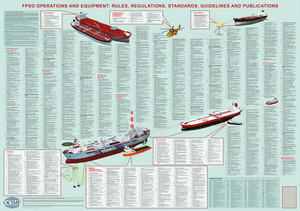
The FPSO Handbook describes marine equipment, oil and gas processing arrangements and legislation relating to the marine and offshore industries.
This book will be of value to those involved in the design, construction, operation, inspection and maintenance of FPSOs, both on and offshore.
The FPSO Handbook covers topics such as design and maintenance of equipment (including the hull, gathering systems, cargo handling systems and pumping and piping systems), training requirements, oil and gas production, fire safety and life-saving arrangements and appliances. The Handbook is supplemented by annexes that outline relevant regulatory documents and conventions.
The exploitation of oil and gas reserves is a relatively new industry when compared to the marine industry which has been around in one form or another for centuries. In an FPSO, the two industries are married together in a very effective union that facilitates the exploitation of oil fields that are located either in waters beyond the reach of a conventional steel jacket structure, or where the field size would not justify the cost of such a permanent installation.
This book, The FPSO Handbook, describes the marine equipment, the oil and gas processing arrangements, and the legislation pertaining to both industries, including marine classification issues. It has been written as a source of reference for marine and offshore professionals and it is envisaged that it will be of value to those involved in the design, construction, operation, inspection and maintenance of FPSOs, whether they are based onshore or offshore.
1 The Hull
1.1 The Concept
1.2 Construction
1.3 Confirmation of Design
1.4 Conversion Versus Newbuild
1.5 Hull Layout and Regulations
2 Gathering Systems
2.1 Mooring Systems
2.2 Fluid Transfer Systems.
2.3 Pipeline Systems and Risers
3 Regulations
3.1 Regulations – Statutory Legislation
3.2 Regulations – Ship Classification
3.3 Regulations – Offshore Legislation
4 FPSO Personnel and Training
4.1 Personnel
4.2 Training Requirements
5. Cargo Handling Systems
5.1 Cargo Handling Systems - Cargo and Ballast System
5.2 Cargo tank vent and inert gas systems
6. Oil and Gas Production
6.1 Oil and Gas Production
6.2 Enhanced Oil Recovery and the Oil Drive Mechanism
7. Pumping and Piping Systems
8. Machinery, Equipment and Safety Systems
8.1 Safety and Emergency Systems
8.2 Emergency Support Systems (ESS)
8.3 Process and Marine Machinery
9. Hazardous Areas, Ventilation and Hazardous Area Equipment
9.1 Hazardous Areas and their Determination
9.2 Ventilation Systems and Machinery in Hazardous Areas
9.3 Hazardous Area Equipment
10. Fire Protection, Fire Detection and Fire Extinction
10.1 Application, Basic Principles and Definitions
10.2 Active Fire-Fighting Systems
10.3 Fire Tests and Material Certification
10.4 Construction and Passive Fire Protection Measures
10.5 Fixed Fire-Fighting Systems
10.6 Miscellaneous Fire-Fighting Items
11. Lifesaving Appliances and Arrangements
11.1 Regulatory Requirements
11.2 Communication
11.3 Personal Lifesaving Appliances
11.4 Survival Craft
11.5 Training, Inspections, Maintenance and Drill
12. Standby Vessels (SBVs) and the Safety and Response Equipment they are Fitted with
12.1 The Ships
12.2 The Equipment
12.3 Communications
12.4 Responsibilities
12.5 The Crews
12.6 The Training
12.7 The Tasks
12.8 Operations
12.9 Additional Duties
12.10 Operation Jigsaw
Appendix I Contents of the consolidated text of the Annex to the 1974 SOLAS Convention
Appendix II Contents of the International Life?Saving Appliance Code
Appendix III Contents of the Code for the Construction and Equipment of Mobile Offshore Drilling Units
Index
Angus Mather commenced his career with the Ministry of Defence at Devonport, in 1970, as a Technician Apprentice. This was followed by 10 years’ service as an Engineer Officer prior to entering the oil and gas industry. The next 25 years were spent employed both in the contracting industry as Engineering Manager of Kvaerner Oil and Gas Services and as a Classification Society surveyor, involved with oil and gas related products, both on and offshore, in the UK, the Middle East, the Gulf of Mexico and West Africa.
- Number of Pages:
- 266
- ISBN:
- 9781905331574
- Published Date:
- August 2009
- Binding Format:
- Paperback
- Book Height:
- 280 mm
- Book Width:
- 160 mm
- Weight:
- 1 kg
- Preview:
- Yes
- Author:
- Angus Mather





